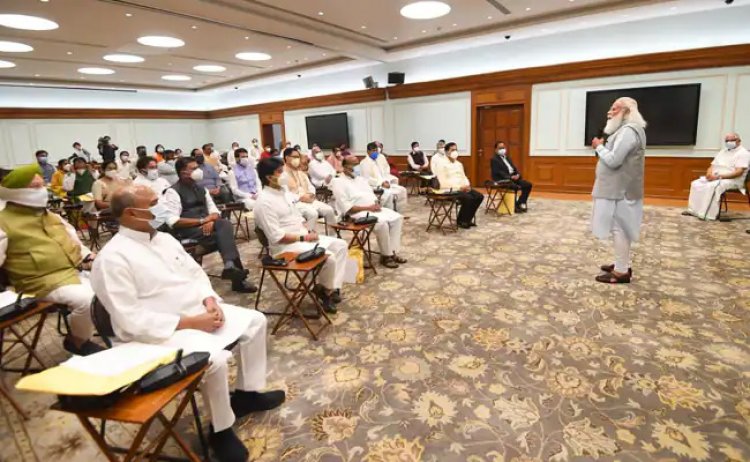Understanding the Cabinet Reshuffle
STORIES, ANALYSES, EXPERT VIEWS

3.0141+0258The cabinet, according to political analyst, Chanakya, writing in The Hindustan Times “will strengthen the BJP politically. Whether it improves the government’s performance is another question, but the entire exercise and the choices made by the Prime Minister (PM) reflect some fundamental strengths of the party, as well as reveal its future direction.”
Chanakya identifies important political dimensions of the cabinet expansion, to understand the governing arrangement.
Inclusive Hindutva
“The first is the steady consolidation of the politics of inclusive Hindutva….Both Modi and Shah have long recognised that the BJP’s hopes of winning elections rested on representing the entire spectrum of Hindu society. This is also in line with the Rashtriya Swayamsevak Sangh’s stated principle of unifying Hindu society….” Towards this end, the party played “on the PM’s appeal and his personal identity as someone from an Other Backward Classes (OBC) sub-group, integrating workers from non-dominant backward and Dalit castes into the party structure, and recognising their history, symbols and leaders.”
Inclusive Hindutva, writes Chanakya “is getting institutionalised in the formal power structure now. With 27 ministers from OBC castes, 12 from Scheduled Castes subgroupings, and eight from the Scheduled Tribes community, the majority in Modi’s government now comes from traditionally marginalised groups. To clarify, this does not mean that the BJP is an all-inclusive party — as long as its outlook towards Muslims doesn’t change, this won’t happen. But it is paradoxically the most inclusive and the most exclusivist party in India’s electoral history…..
Realpolitik calculations
“To be sure, the BJP’s inductions were driven by realpolitik calculations, especially the north Bengal appointments……But it does not take away from the geographical spread of the BJP, crucial for the party’s self-image as a national force. The party will continue with its outreach in new areas, and electoral success, in turn, will slowly impact the structure and representation patterns of the party. The Cabinet expansion is a step in that process.”
Recognition that the politics of performance: The cabinet expansion is also “Modi’s recognition that the politics of performance is crucial to legitimacy. The government has faced its most serious erosion of credibility in the past year, with simultaneous national security, public health and economic crises. The mismanagement of the second wave affected, in varying degrees, the trust in the PM himself….”
Cabinet appointments in key positions have thus “been (largely but not exclusively) driven by who the PM sees as meritorious, what he identifies as priority sectors, and how he has aligned the two.”
The politics of inclusive Hindutva, spatial expansion and performance legitimacy is driven by another variable — “the politics of electoral and party-building imperatives. These include preparing the party for state elections in the next three years, grooming a new generation of leaders, winning over crucial caste vote banks, changing the narrative on governance, and preparing for 2024.
“The BJP has been quick to understand the shift in public mood, act on feedback, and make changes. Whether the strategy works, and governance improves, is to be seen.”
‘A political exercise with focus on states going to the polls next year’
If there is one message that emerges from the ministerial reshuffle and expansion, Zoya Hasan (Professor Emerita, Centre for Political Studies, JNU) writes, it is this: “The reset was a political exercise with focus on states going to the polls next year. Elections to the Assemblies of Gujarat, Uttar Pradesh, Punjab, Uttarakhand and a few others are due in 2022 and to Karnataka, Madhya Pradesh, Rajasthan and Telangana in 2023. The more interesting dimension of this political exercise is the elaborate attention given to the caste configuration of the Cabinet and the manner in which it was publicised by the BJP……..The idea is to bring together Hindus under the banner of Hindutva, while painting Muslims as the ‘other’……..”
Greater representation to OBCs and Dalits to keep them under the Hindutva umbrella: The new Cabinet is therefore, “in step with this strategy of giving greater representation to OBCs and Dalits to keep them under the Hindutva umbrella. In fact, the reshuffle reinforces this strategy which has been the key to the party’s political success in north India, especially in Uttar Pradesh. With 14 ministers, the state now accounts for the largest chunk of ministers……..
“Careful social engineering and the widely discussed details of the caste composition of the Cabinet revamp have effectively positioned the BJP as a champion of the OBCs, which is crucial to the maintenance of its dominance of Uttar Pradesh and other Hindi-speaking states, where the combination of caste and communal politics helps to unite these microscopic groupings. Equally significant in this regard is the exclusion of Muslims……..
Exclusion of Muslims: “The exclusion of Muslims is not surprising but that it has gone unnoticed is somewhat surprising. But whether all this will offset the resentment that has been brewing with the loss of lives and livelihoods and the disastrous management of the second wave in various states, particularly Uttar Pradesh, is not known yet. If the party fails to retain UP, its political dominance will be shaken.”
















